Arizona Bark Scorpion
Centruroides sculpturatus
Under UV light they glow a bright blue or green, making them easy to spot.
Advertisement
Arizona Bark Scorpion Facts
- Prey
- insects, spiders, centipedes and other scorpions
- Name Of Young
- scorplings
- Group Behavior
- Colonial Nesting
- Fun Fact
- Under UV light they glow a bright blue or green, making them easy to spot.
- Biggest Threat
- natural predators and pesticides
- Most Distinctive Feature
- 2 pedipalps like "crab claws"
- Gestation Period
- 9 months
- Litter Size
- up to 30
- Habitat
- deserts
- Diet
- Carnivore
- Type
- Anthropod
- Common Name
- Arizona Bark Scorpion
- Number Of Species
- 1
- Location
- California, Arizona, New Mexico and Mexico
Arizona Bark Scorpion Physical Characteristics
- Color
- Light-Brown
- Skin Type
- Exoskeleton
- Lifespan
- 5-7 years
- Weight
- 2 ounces
- Height
- less than 0.25 inches
- Length
- 7-8 centimeteres
- Age of Sexual Maturity
- 1 year
- Age of Weaning
- 1 to 3 weeks (leaves mother's back)
View all of the Arizona Bark Scorpion images!
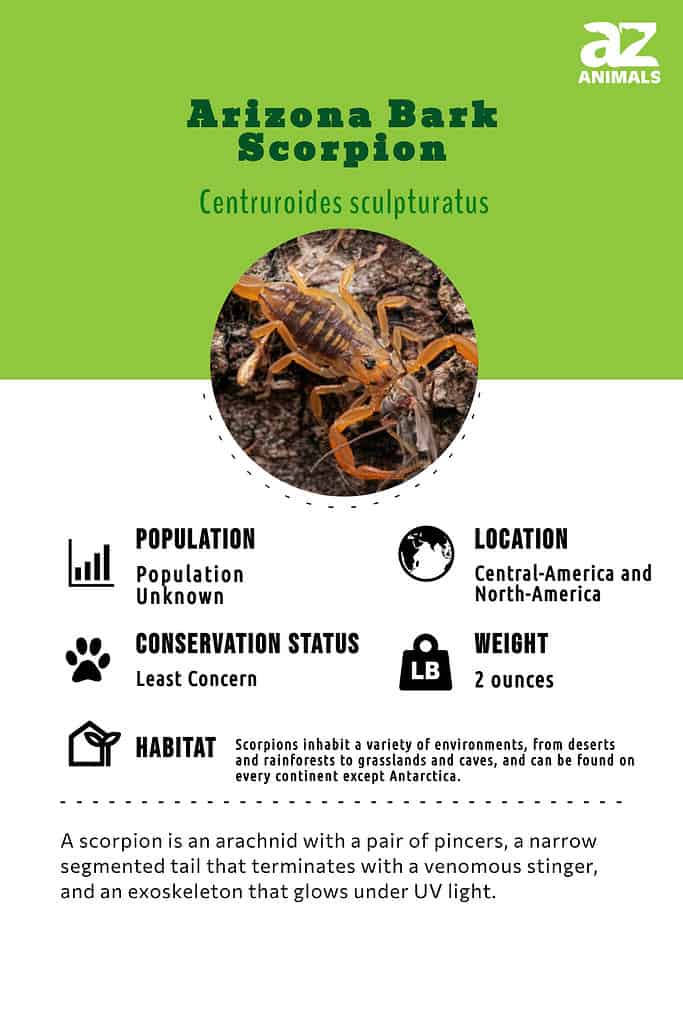
“Under UV light the Arizona bark scorpion glows bright blue or green.”
The Arizona bark scorpion is a small but potentially deadly arachnid native to the Sonoran Desert of the United States and southwestern Mexico. Adult males only grow to about 3.14 inches and females up to seven inches.
These resilient creatures live up to seven years on average with some known to live as long as nine years. During nuclear testing by the United States, bark scorpions found at ground zero showed no negative side effects from exposure.
4 Incredible Arizona Bark Scorpion Facts!
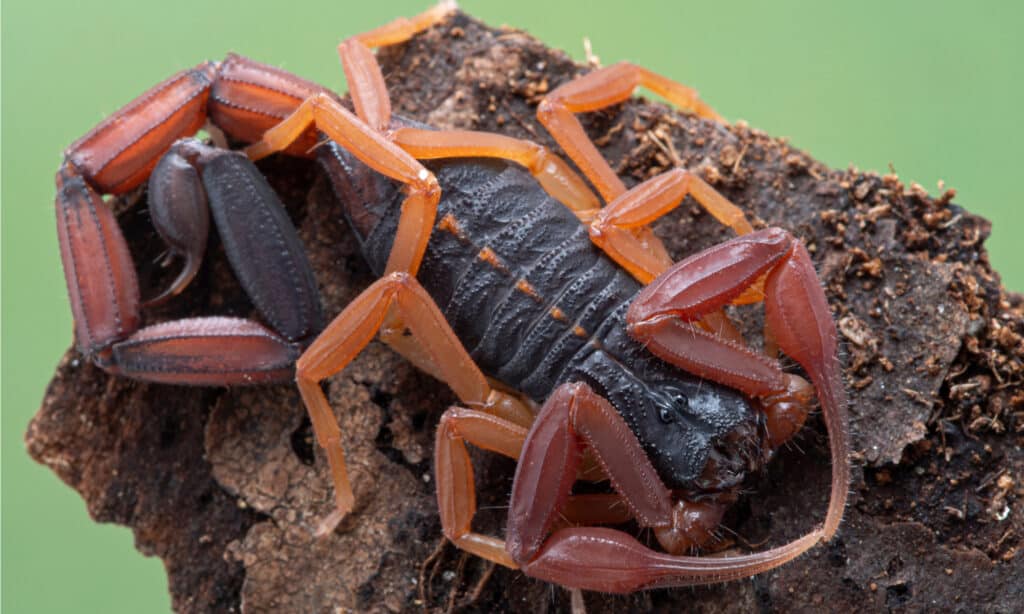
The gestation period for the Arizona bark scorpion is comparable to that of humans, lasting approximately nine months.
©Ernie Cooper/Shutterstock.com
- Arizona bark scorpion gestation is the same as humans, which is nine months.
- An average of 30 babies are born to females in one litter
- Surviving hot, dry summers in extreme desert conditions, the scorpions hibernate in groups of up to 40 for winter.
- Their sting is potentially deadly to humans.
Species, Types, and Scientific Names
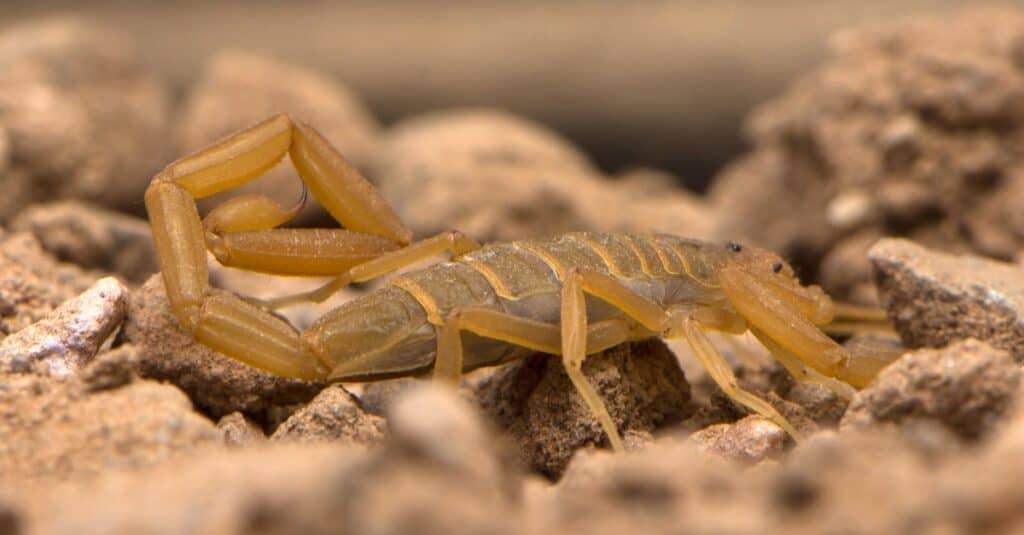
The small size of the Arizona bark scorpion
(Centruroides sculpturatus)
belies its deadly potential, making it one of the most feared creatures in the American Southwest.
©iStock.com/Ledzeppelinriff
The Arizona bark scorpion (Centruroides sculpturatus) is one of the most feared creatures in the American Southwest because it is small but deadly. The scorpion’s sting is highly toxic and painful to most creatures except grasshopper mice. Alongside about 69 other species, it belongs to the Buthidae family and the genus Centruroides.
The Arizona bark scorpion was formerly known as Centruroides exilicauda along with California bark scorpions. But reclassification distinguishes the Arizona bark scorpion as its own species, the only one with a potentially deadly sting. The name sculpturatus is Latin, meaning “of or belonging to sculpture.” It refers to the scorpion’s tergite dorsal plates which appear sculpted.
Some of the 69 types of bark scorpions in the same genus include striped bark scorpions (Centruroides vittatus). These are found mostly in the southcentral and southwestern United States including Arizona, Arkansas, Colorado, Louisiana, Montana, Nevada, New Mexico, Oklahoma, Texas, Utah, and Wyoming. Although they look much like an Arizona bark scorpion, the striped bark species has two distinct brown stripes running the length of their back that make them easy to identify. They do not have a deadly sting.
In their arid habitat, Arizona bark scorpions have suspected biomass that exceeds all other vertebrates in their region. Scientists believe this high biomass contributes to the scorpions’ tendency toward cannibalism.
Evolution and Origins
As per recent summarization, it is believed that scorpions initially existed as water-dwelling creatures. There is strong evidence to suggest that they evolved from a group of organisms called Eurypterida, also known as ‘water scorpions’, due to the presence of similar physical characteristics shared by both species.
According to scientific theories, scorpions are believed to have originated on land but eventually got swept into the ocean where they underwent an evolution during their time there. They then emerged again, possibly around 400 million years ago.
Scorpions usually undergo five to six molting stages in their life cycle before reaching maturity. Although their growth rate is slow, scorpions have a longer lifespan as compared to spiders and insects, typically living for three to five years.
However, certain species can survive up to ten to fifteen years.
Different Types
Here are the different types of scorpions:
- Emperor scorpion
- Deathstalker
- Tityus serrulatus
- Brazilian scorpion
- Arizona bark scorpion
- Tetratrichobothrius flavicaudis
- Heterometrus
- Giant hairy scorpion
- Heterometrus spinifer
- Euscorpius italicus
- Hottentotta tamulus
- Fattail scorpion
- Bark scorpions
- Pandinus
- Flat rock scorpion
- Arrowbreasted scorpions
- Euscorpius
- Brontoscorpio anglicus
- Stripe-tailed scorpion
- Chaerilus
- Vaejovis
- Bothriurus
- Cercophonius squama
- Iurus
- Nebo hierichonticus
- Kolotl
- Hadogenes
- Diplocentrus
- Caraboctonidae
- Scorpionoidea
- Pseudochactoidea
- Chaeriloidea
- Iuridae
- Chactoidea
- Belisarius
Appearance
The Arizona bark scorpion is brown with two body segments, the cephalothorax, and the abdomen. It has eight legs and two pedipalps that look like miniature crab or lobster claws. These pedipalps are used to sense the environment and grab prey.
The tail that curls up over the body has five segments with a stinger at the end. Males measure up to eight centimeters long and females typically grow to seven centimeters with both sexes’ average weight at around two ounces.
When the Arizona bark scorpion stings a human, it is believed that its deadly venom travels through the victim’s body by way of the lymphatic system. Once stung, the victim suffers pain immediately at the sting site. Within four hours, the symptoms set in and can prove deadly.
Emergency treatment is necessary after a sting. In sting victims given Arizona bark scorpion antivenom, symptoms were relieved within 30 minutes for 71% of patients. Goats are used by scientists to make antivenom for human treatment.
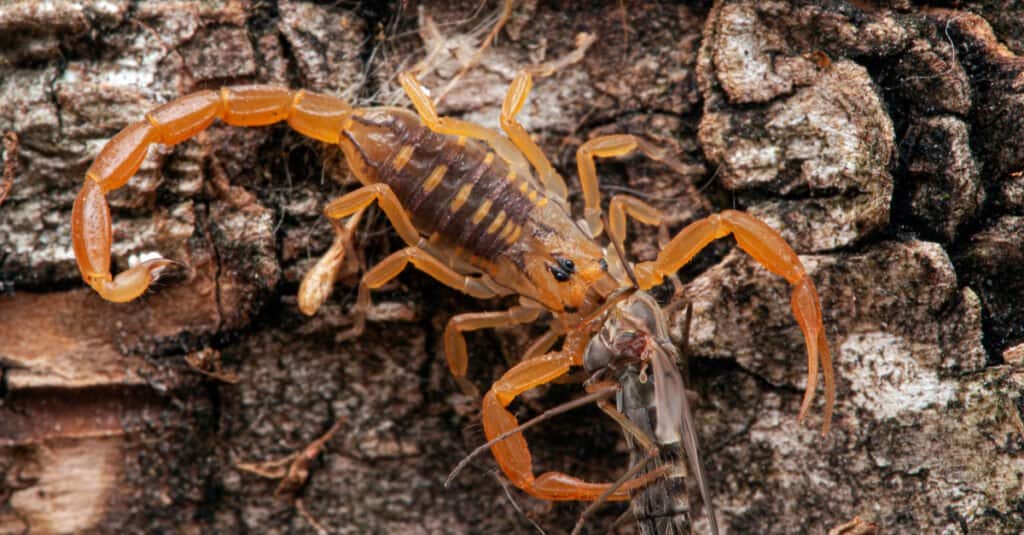
©Ernie Cooper/Shutterstock.com
Habitat
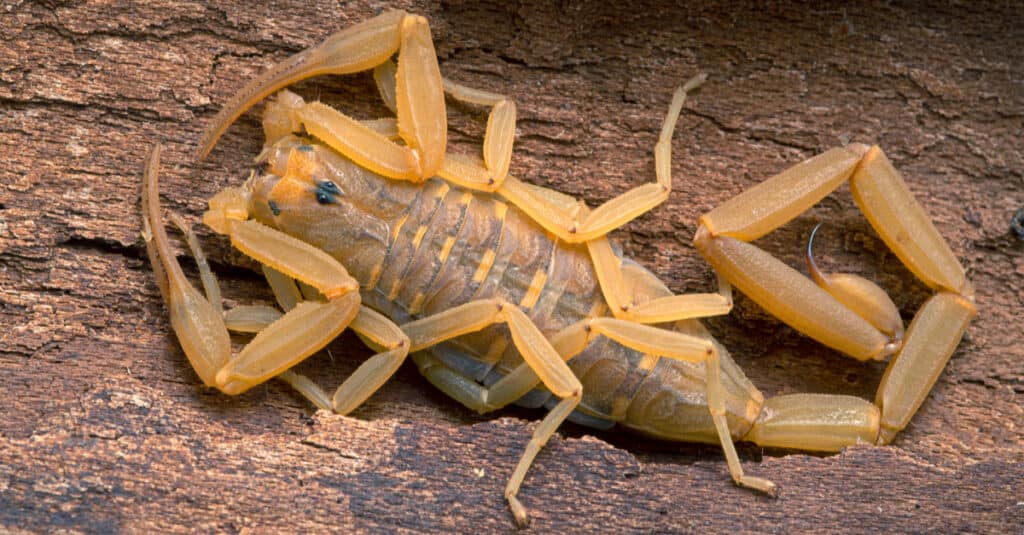
Arizona bark scorpions are indigenous to the Sonoran Desert and found in Arizona, as well as in Baja California and
Chihuahua
.
©Ernie Cooper/Shutterstock.com
Arizona bark scorpions are native to the Sonoran Desert of Arizona and also live in Baja California and Chihuahua. Their range extends from southern Arizona into southern California, western New Mexico, and northern Mexico. They thrive in warm climates and hibernate in winter.
The scorpions are easy to find throughout the Grand Canyon and even on the canyon walls. Its common name comes from the creature’s ability to climb high into trees or on rock walls. But it also lives on and beneath the ground level, under rocks, and in crevices. In people’s homes, they are found on walls, in dark spaces like closets, at the base of toilets, in shoes, or trapped in sinks and bathtubs.
Centruroides sculpturatus lives, travels, and hibernates for the winter in groups of up to 40 individuals. A sighting of one of these scorpions means many more are likely nearby, usually hidden from view. Female scorpions can have 30 or more young at once. These scorplings live on the mother’s back until they molt the first time, sometime between one and three weeks.
Diet
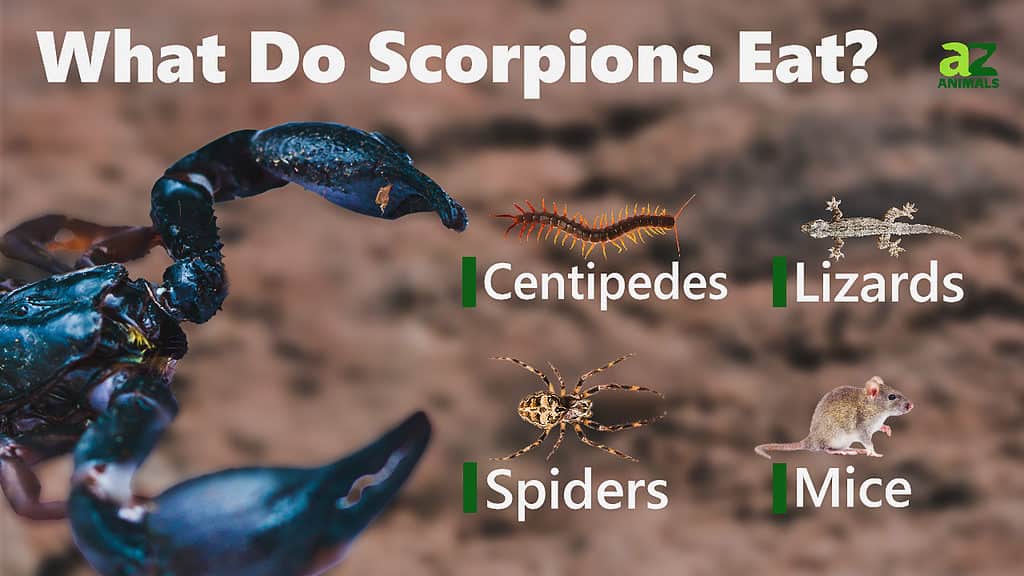
Arizona bark scorpions are true predators. Thanks to their highly venomous stinger and pedipalps, they are well-armed to grab and immobilize their prey within milliseconds. Still, many animals consider these threatening creatures tasty prey.
What eats Arizona bark scorpions?
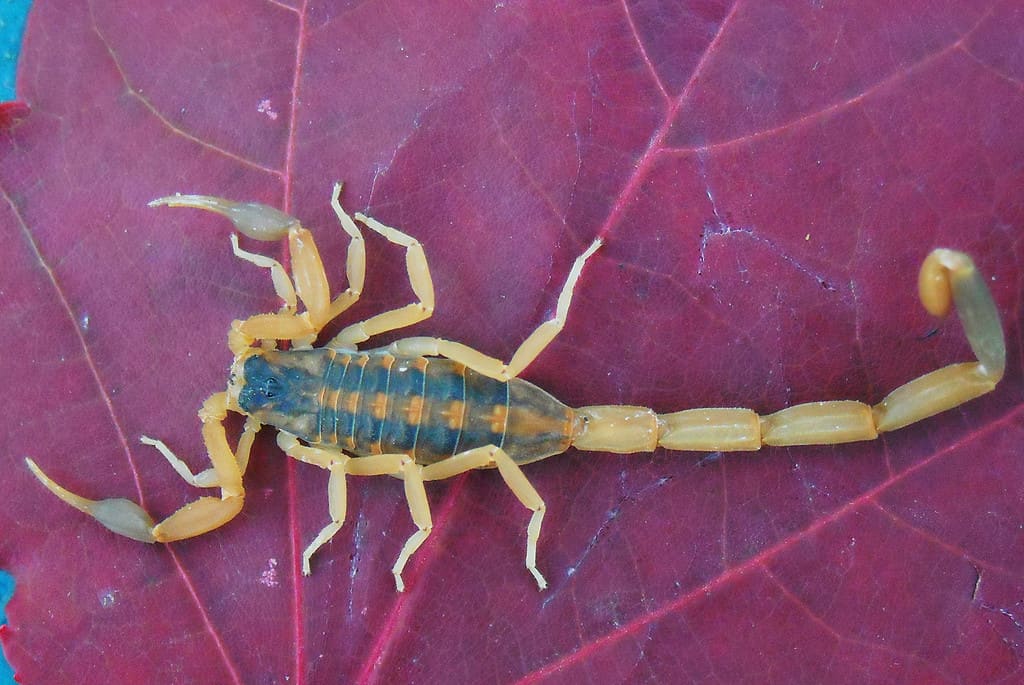
Bats, tarantulas, lizards, owls, and birds will eat scorpions.
©Matt Levi Media/Shutterstock.com
Surprisingly, many animals are willing to risk the Arizona bark scorpion’s sting to make them a tasty meal. One such animal even has interesting adaptations to make eating the scorpion easier. Among their predators are bats, large centipedes, tarantulas, lizards, owls, other birds, shrews, and grasshopper mice.
Grasshopper mice have adaptations for hunting these scorpions. They have evolved for resistance to their prey’s venom. This is one of the most interesting facts about the animal world. Instead of being poisoned by the scorpion’s sting, grasshopper mice internally process the venom into a painkiller.
As Centruroides sculpturatus’ venom has evolved in strength, so have the grasshopper mouse’s adaptations for resisting the venom.
What do Arizona bark scorpions eat?
The preferred meals of Centruroides sculpturatus include centipedes, spiders, crickets, roaches, and other scorpions, as well as any other insects they find. They have poor eyesight but hunt at night using tiny hairs on their body to sense vibrations and movement.
Because they can run up to 12 miles per hour, the scorpion can easily target, chase and grab prey using their pedipalps. They quickly deliver a deadly sting to kill the insect or other creature and then eat them. Bark scorpions can go several days without eating and will cannibalize their own kind if needed.
Prevention
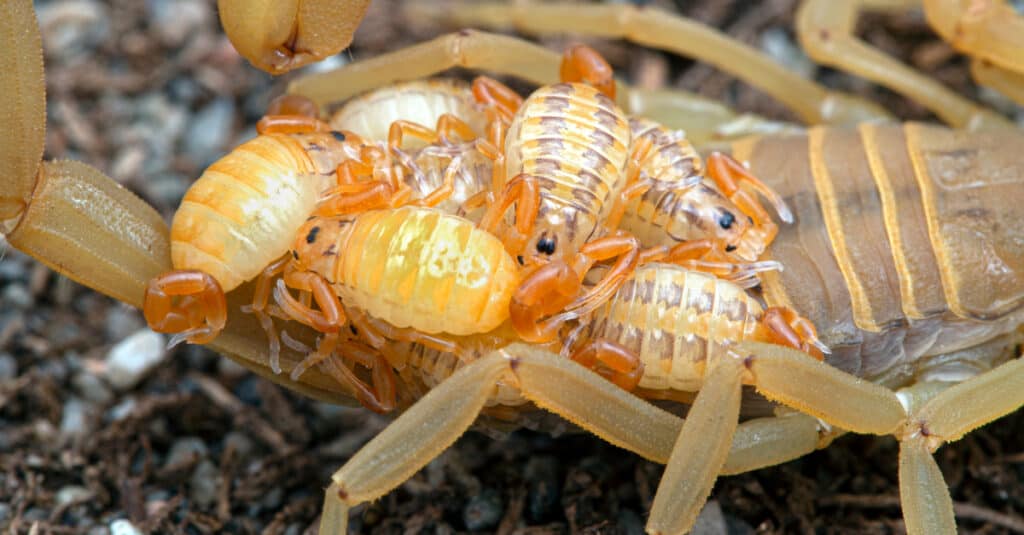
Arizona bark scorplings on their mother.
©Ernie Cooper/Shutterstock.com
Arizona bark scorpions are a big problem for many homeowners. Important facts are these mighty little stingers can be deadly to cats, dogs, the elderly, children, and adults with compromised immune systems.
Symptoms of a sting include convulsions, breathing problems, muscle twitching, frothing at the mouth, numbness, and even death. If a person is stung on their arm or leg, that limb can stay numb for 72 hours or more. Most deaths occur in people with allergic reactions to venom.
Antivenom used to treat the sting is usually processed from goats and can cause negative side effects of its own, called “serum sickness.” For these reasons and the dangers they present, Arizona bark scorpions are pests most homeowners do not want within their walls.
Homeowners and pest control experts take many steps to prevent Arizona bark scorpion entry into homes and the invasion of lawns. These include the placement of smooth physical barriers designed to prevent the climbers from entering related areas since they cannot climb smooth surfaces.
Other methods include the placement of glue boards around perimeters and places where they are frequently seen. Pesticides are used to kill existing scorpions and prevent more from coming inside or around specific areas of the outdoors. Because scorpions like to hide in dark, moist, and cool areas, it is helpful to remove wood piles and other congregation areas around the home that may be attractive to them.
View all 194 animals that start with AArizona Bark Scorpion FAQs (Frequently Asked Questions)
Are bark scorpions dangerous?
Arizona bark scorpions are the only potentially deadly scorpion in the United States. They have a painful and highly venomous sting that is particularly dangerous to young children, pets, the elderly, and people with compromised immune systems. Most people who die from the sting are allergic to venom.
How many legs does a bark scorpion have?
Like other arachnids in the class Arachnida, Arizona bark scorpions have eight legs. They also have two front pedipalps that look like tiny crab or lobster claws and a five-segmented tail with a stinger at its end.
How do you get rid of bark scorpions?
You can prevent these scorpions from invading your home or lawn by removing debris where they can hide, such as wood piles. Seal cracks in the building like those around baseboards. Once they have come into your home, you can use pesticides or have a professional exterminator do this for you.
How do I identify an Arizona bark scorpion?
An Arizona bark scorpion is a solid light brown, not striped like its cousin, the striped bark scorpion. It has two body segments, eight legs, two front pedipalps, and a five-segmented tail with a stinger at the end that raises up above its body when threatened. Females typically measure about 7cm long and males measure 8cm.
What is an Arizona bark scorpion?
Arizona bark scorpions are arthropods in the class Arachnida. It is a type of insect most closely related to spiders and other scorpions. But this one is the most venomous scorpion in the United States, the only one with a potentially deadly sting. It lives in Arizona, New Mexico, California, and Mexico.
What does an Arizona bark scorpion eat?
Arizona bark scorpions eat a variety of insects. Their preferred diet includes centipedes, spiders, crickets, roaches, and other scorpions.
What do I do if I'm stung by an Arizona bark scorpion?
If you are stung by this scorpion, it is important to call for emergency medical service or go to the emergency department of your nearest hospital. Its venom can cause serious allergic reactions in some people. In those cases, goat-produced antivenom can provide lifesaving treatment.
Are bark scorpions deadly?
Arizona bark scorpions are the only type of scorpion in the United States that can kill people. These deaths are rare but happen from time to time. For most people, the sting causes severe pain at the injury site and other symptoms like numbness.
Are Arizona bark scorpions the most poisonous scorpions?
These scorpions are the most poisonous scorpions in the United States. No other American scorpion can cause the death of a human being.
How big does an Arizona bark scorpion get?
Most male Arizona bark scorpions grow to about 8cm. Females grow to seven cm on average. However, these scorpions are sometimes spotted at lengths of up to nine cm.
Thank you for reading! Have some feedback for us? Contact the AZ Animals editorial team.
Sources
- Wikipedia / Accessed October 11, 2021
- Arizona-Sonora Desert Museum / Accessed October 11, 2021
- KY-KO Pest Prevention / Accessed October 11, 2021
- Orkin / Accessed October 11, 2021
- NMSU / Accessed October 11, 2021
- Critter Science / Accessed October 11, 2021
- responsible pest & scorpion control / Accessed October 11, 2021
- Insectek / Accessed October 11, 2021


















